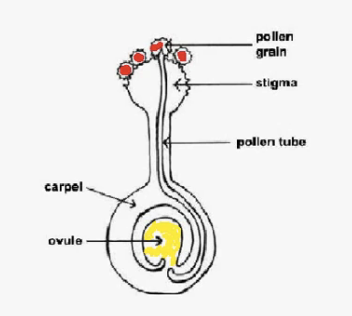Growth of the pollen tube followed by fertilization leads to seed & fruit making.
1. The pollen nucleous fertilizes the ovule, this forms the Zygote which develops into an embryo, then turns into the embryonic plant, - travels down the pollen tube.
2. Outside the ovule the seed coat forms called the Testa.
3. Cotyledons are food stores for the seedling, (it supports the plant for it's first set of leaves.)
4. Th plant put a lot of energy to thicken walls, and make fruit. (thicken walls of ovary + carpel.
5. The ovary develops into fruit & the ovule develops into seed.
Saturday, April 9, 2011
Monday, April 4, 2011
3.3 - Flower structure + pollination
Observation on Lily
Pollination: arrival of pollen at stigma.
diagrams+measurements from lesson:
Measurements - 1 petal: length 12.6cm width - 4cm
& - number of sepals: 3 number of petals: 6
Appearance - scent: yes color: pink + white
Stamen (male): forms part of a circle around the carpel.
Carpel (female): is in the center of the flower
Sepal(s): looks like a petal on the lily, but is part of the outside layer
Petal: attracts insects for pollination by colour
Ovary: is where seeds are produced
Filament: supports the anther
Anther: produces pollen
Style: connects ovary + stigma
Stamens(male): each consist of anther
Stigma: receives pollen
Pollination: arrival of pollen at stigma.
diagrams+measurements from lesson:
Measurements - 1 petal: length 12.6cm width - 4cm
& - number of sepals: 3 number of petals: 6
Appearance - scent: yes color: pink + white
Stamen (male): forms part of a circle around the carpel.
Carpel (female): is in the center of the flower
Sepal(s): looks like a petal on the lily, but is part of the outside layer
Petal: attracts insects for pollination by colour
Ovary: is where seeds are produced
Filament: supports the anther
Anther: produces pollen
Style: connects ovary + stigma
Stamens(male): each consist of anther
Stigma: receives pollen
Friday, April 1, 2011
3.3b Wind Pollination
Structure of wind-pollinated flower + how each is adapted for pollination:
Transfer: pollen grain from anther -> stigma by air + wind.
Features:
1. They travel by wind easily as pollen grains have a light weight.
Most grains have a "wing" feature, which enables them to be transported more efficiently.
2. Exposed anthers help, as they hang outwards, more exposed to the wind.
3. Exposed stigmas help as well as they have a large surface area, + a "feather like" structure, having this traps more pollen better.
Transfer: pollen grain from anther -> stigma by air + wind.
Features:
1. They travel by wind easily as pollen grains have a light weight.
Most grains have a "wing" feature, which enables them to be transported more efficiently.
2. Exposed anthers help, as they hang outwards, more exposed to the wind.
3. Exposed stigmas help as well as they have a large surface area, + a "feather like" structure, having this traps more pollen better.
3.3a Insect Pollination
Structures of an insect-pollinated flower + Adaptation for pollination:
In process of pollinating flower, there is a transfer of "pollen."
Pollen: contanins the male nuclei + source of protein.
Transferred by: Insects.
Cross pollination: insects take pollen from one flower to another.
Insects:
They get attracted by signals: brightly colored petals, petal shape, + food reward – pollen &/or nectar, fragrance
Carpel: Female organs of flower:
In process of pollinating flower, there is a transfer of "pollen."
Pollen: contanins the male nuclei + source of protein.
Transferred by: Insects.
Cross pollination: insects take pollen from one flower to another.
Insects:
They get attracted by signals: brightly colored petals, petal shape, + food reward – pollen &/or nectar, fragrance
Carpel: Female organs of flower:
- Stigma: collects the pollen from the pollinating insect , & stimulates pollen germination.
- Style: positions the stigma for effective pollen collection.
- Ovary: site of fertilisation, protects the developing seeds, aids in seed dispersal.
- Anther: pollen formation & release.
- Filament: positions the anther for effective pickup of pollen by the pollinating insect.
Subscribe to:
Posts (Atom)












